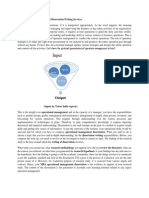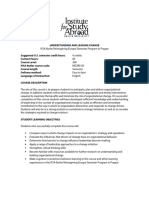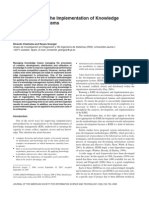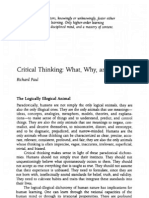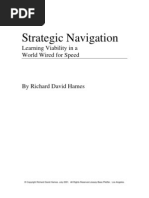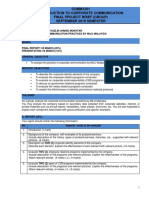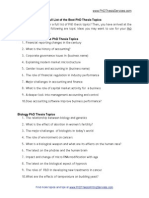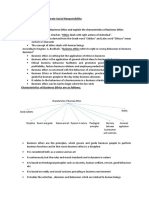People and Organisation Management in The Built Environment
People and Organisation Management in The Built Environment
Uploaded by
NanthiniCopyright:
Available Formats
People and Organisation Management in The Built Environment
People and Organisation Management in The Built Environment
Uploaded by
NanthiniOriginal Description:
Original Title
Copyright
Available Formats
Share this document
Did you find this document useful?
Is this content inappropriate?
Copyright:
Available Formats
People and Organisation Management in The Built Environment
People and Organisation Management in The Built Environment
Uploaded by
NanthiniCopyright:
Available Formats
School of Energy, Geoscience, Infrastructure and Society, Heriot-Watt University 2017/18
COURSE GUIDE
D31PO: People and Organisation Management in the Built Environment
This course focuses on people and organisational management. It will introduce key concepts of
management, including management theories, nature of organisations, leadership, motivations, etc.
In addition to introduction to basic theory, the course will explore the application of these concepts
in business management, especially in the context of the construction industry. Students will be
encouraged to relate the course materials to their own experience and to reflect on their personal
development in a synoptic way. It is hoped that this will be valuable in terms of career development,
as management competences and self-reflection are increasingly sought in practice.
Course Aims
1. To develop an understanding of people management and its relation to both personal and
organisational objectives
2. To develop an understanding of the principles of management in organisations and of
management techniques
3. To learn how management relates to organisations and individuals in managing change
4. To develop an understanding of contemporary good practice in management concepts,
including recent initiatives
Learning Outcomes
Knowledge:
A high level of knowledge about complex management theories and their application in built
environment organisations, including applied research findings and current good practice
techniques
An understanding of the complexity of management concepts and their application in
practice
An understanding of the importance of management in shaping and influencing the aims of
built environment organisations and its application in practice
To understand the multi-faceted relationships between organisational management and an
individual’s personal motivation and objectives
An understanding of the role of management competencies in continuous professional
development
Skills:
To develop skills in critical and creative analysis of theory and practice in management topics
To explicitly develop a professional level of inter-personal, interdisciplinary, and team
working skills
Values:
To recognise the crucial role employees play in effectively meeting organisational goals
To recognise the importance of the management and interpersonal skills that underpin a
professional’s technical competence
Assessment
This course will be assessed through a 2 hour written examination (100%).
D31PO People and Organisation Management in the Built Environment 1|Page
School of Energy, Geoscience, Infrastructure and Society, Heriot-Watt University 2017/18
Course Structure
The following topic guide outlines the main subjects in the sequence they will be covered over the
course.
Unit 1 Introduction to Management
Unit 2 Organisational Strategy
Unit 3 Organisational Structure
Unit 4 Work Groups and Conflict Management
Unit 5 Organisational Culture and Change
Interim Review & Mock Exam
Unit 6 Leadership
Unit 7 Motivation and Job Satisfaction
Unit 8 Individual Differences and Diversity
Unit 9 Control and Power
Unit 10 Social responsibility and Ethics
Final Review & Mock Exam
Reading List
Core Readings
This course uses Naoum (2011) as the core textbook and Mullins and Christy (2013) as a
supplementary textbook:
Naoum S. (2011) People and Organizational Management in Construction, Institution of Civil
Engineers Publishing (available as e-book on Vision)
Mullins L. and Christy (2013) Management and organisational behaviour (10th Ed.), Financial
Times Prentice Hall, Harlow (available as e-book on Vision)
Optional Readings
There is a large range of books available, which cover relevant topics, including:
Cole, G.A. (2011) (7th Ed.) Management Theory and Practice, Letts Educational, London.
Debra L. Nelson., James Campbell Quick (2011) (2nd Edition), ORGB 2, Cengage
Rollinson, D. (2008) (4th Edition) Organisational Behaviour and Analysis, prentice Hall
Clegg, S., Kornberger, M. and Pitsis, T. (2005) Managing and Organizations: An Introduction
to Theory and Practice. Sage. London
Clegg, S., Kornberger, M. and Pitsis, T. (2008) (2nd Ed.) Managing and Organizations: An
Introduction to Theory and Practice. Sage. London
Grey, C. (2008) (2nd Ed). A very short, fairly interesting and reasonably cheap book about
studying organizations. Sage. London
Handy, C. (1993). Understanding organizations. Penguin. London
Whetten D. A. and Cameron K. S., (2004) Developing Management Skills, 6th Edition,
published by Prentice Hall
A list of journal articles are provided on Vision, to demonstrate the application of management
theories in construction practice.
D31PO People and Organisation Management in the Built Environment 2|Page
School of Energy, Geoscience, Infrastructure and Society, Heriot-Watt University 2017/18
Learning Units
The following outlines the ten learning Units; each Unit has a list of learning outcomes. Exam
questions will be related to these learning outcomes.
Unit 1 Introduction to Management
Management is an integral part of modern business. It is essential to the success of an organisation
or a project. There may be variations of specific management tasks in different situations. However,
there are also some common management principles. This first Unit starts with the definition of
management and the main tasks of management. It also introduces the evolution of different
approaches to management.
Specific learning outcomes of this Unit include:
Students should understand the meaning and essential features of management and its
relevance to business practice
Students should know the main tasks of management and their application in a business
management setting, such as managing construction projects
Students should have knowledge of the main management principles, as suggested by Fayol;
Student should gain knowledge of the different approaches to management; and be able to
compare the different approaches, including:
o Classical approach
o Human relations approach
o Systems approach
o Contingency approach
Essential reading:
Lecture slides
Mullins L. and Christy (2013), 421-431
Naoum (2011), Chapter 2: Evolution of Organisation and Management Theory
Unit 2 Organisational Strategy
An organisational strategy refers to actions that the organisation intends to take in order to achieve
its business objectives. It usually looks at the long term and is influenced by the external
environment. This Unit discusses the implication of organisational strategy; different types of
strategy; and the influencing factors. It also covers the process of developing an organisational
strategy.
Specific learning outcomes of this Unit include:
Students should understand the importance of organisational strategy;
Students should know the main external factors that have an influence on an organisational
strategy;
Students should be able to compare reactor approach and planned approach to
organisational strategy;
Students should know the main stages of the strategy development process and the main
tasks at each stage;
Students should be familiar with the SWOT analysis technique.
Essential reading:
Lecture slides
Naoum (2011), Chapter 3: The Environment and Organisational Strategy
Mullins L. and Christy (2013), 500-508
Unit 3 Organisational Structure
Organisation is the basic unit of economic and social activities in modern society. There are different
types of organisations for different purposes. Every organisation should adopt a most suitable
D31PO People and Organisation Management in the Built Environment 3|Page
School of Energy, Geoscience, Infrastructure and Society, Heriot-Watt University 2017/18
internal structure in order to achieve its organisational strategy and objectives. This Unit introduces
the basic structure of an organisation and several common types of organisational structure. It also
covers different aspects of organisational structure design and the main influencing factors.
Specific learning outcomes of this Unit include:
Students should know the main components of a typical organisation;
Students should understand the main elements of organisation design;
Students should know the influencing factors or main determinants of organisation design;
Students should know the main features and applicability of five organisation structures
suggested by Henry Mintzberg;
Students should understand the main characteristics of project based organisations.
Essential reading:
Lecture slides
Naoum (2011), Chapter 4: Organisational Structure
Unit 4 Work Groups and Conflict Management
Work groups are usually the basic building blocks of organisational structure. Construction projects
are delivered by project teams, which in essence are work groups. This Unit explains the nature of
work groups; group cohesion and its influencing factors; and the group development stages. It also
covers the inevitable issue of conflicts; common causes of conflicts; and different approaches to
conflict management.
Specific learning outcomes of this Unit include:
Students should know the main factors influencing group/team cohesiveness and
performance;
Students should know Tuckman’s team development process;
Students should understand the concept of conflict and the evolving views of the nature and
potential impact of conflict;
Students should know the distinction between constructive (functional) conflicts and
relationship (dysfunction) conflicts; as well as the potential benefits of the former and
damages of the latter;
Students should be aware of the common causes for conflicts;
Students should know the five approaches to conflict management and their suitability;
compare them in objective, posture, rationale and possible outcomes.
Essential reading:
Lecture slides
Naoum (2011), Chapter 5: Work Groups
Mullins L. and Christy (2013), 98-104
Unit 5 Organisational Culture and Change
Organisational culture defines the characteristics of an organisation and the way it behaves. This
Unit discusses the meaning of organisational culture; various types of culture; and the factors that
influence organisational culture. Organisational culture and the organisation itself are not constant;
they change over time in order to adapt to changes in internal and external factors. This Unit covers
the important issues related to organisational change.
Specific learning outcomes of this Unit include:
Students should know about organisational culture and the common types of culture;
Students should know the main factors that influence organisational culture;
Students should understand the benefits and main drivers of organisational change;
Students should know the main barriers to organisation change at both individual and
organisation levels
D31PO People and Organisation Management in the Built Environment 4|Page
School of Energy, Geoscience, Infrastructure and Society, Heriot-Watt University 2017/18
Students should know the steps of successful organisational change, as suggested by Kotter
and Cohen.
Essential reading:
Lecture slides
Naoum (2011), Chapter 6: Organisational Culture
Mullins L. and Christy (2013), 711-720
Unit 6 Leadership
Leadership is closely related to management; but it also distinguishes from management. Leadership
is about “getting others to follow” or “getting people to do things willingly”. There are different ways
of exercising leadership; and the result may also differ. This Unit discusses the nature of leadership
and compares it with management. It then explores different approaches to leadership and different
leadership styles.
Specific learning outcomes of this Unit include:
Students should understand the nature of leadership;
Students should understand the comparison between leadership and management;
Students should know the different approaches to leadership:
o Traits approach;
o Functional approach;
o Behavioural approach;
Students should know the characteristics of the different styles of leadership:
o Authoritarian;
o Democratic;
o Laissez-faire;
Students should know the main principles of contingency leadership theories and
understand their implications in management practice;
Students should be able to compare transactional and transformational leaderships.
Essential reading:
Lecture slides
Naoum (2011), Chapter 7: Leadership
Mullins L. and Christy (2013), 375-379
Unit 7 Motivation and Job Satisfaction
Good performance requires staff being both ‘able’ and ‘willing’ to try their best. Motivation deals
with the ‘willing’ aspect of human behaviour. It helps to understand why people behave in certain
way. This Unit introduces the concept and principles of motivation. It also discusses the main factors
that influence staff motivation in a workplace and ways of increasing motivation and job satisfaction.
Specific learning outcomes of this Unit include:
Students should know the meaning of motivation;
Students should know the principles of the two main groups of motivation theories, and
example theories in each group:
o Content theories: Maslow, ERG, Two-Factor;
o Process theories: Expectancy model, Equity theory, Goal theory;
Students should know the main factors that influence staff motivation in a workplace;
Students should know how to enhance job satisfaction through job design;
Students should understand the relationship between motivation and performance.
Essential reading:
Lecture slides
Naoum (2011), Chapter 8: Motivation and Job Satisfaction
D31PO People and Organisation Management in the Built Environment 5|Page
School of Energy, Geoscience, Infrastructure and Society, Heriot-Watt University 2017/18
Unit 8 Individual Differences and Diversity
Most business organisations consist of many individual workers in different roles. These individuals
may differ in a variety of ways, such as physique, gender, ethnic origin, value, culture background,
etc. The differences can foster creativity, enjoyment, and satisfaction. They can also be sources of
misunderstanding and conflict. In any case, it is important for managers to recognise individual
differences and understand the demands of each individual.
Specific learning outcomes of this Unit include:
Students should know what personality is about.
Students should understand the two approaches of personality studies - Nomothetic
approach and Idiographic approach
Students should appreciate the potential link between personality and job performance.
Students should understand equality and diversity in a workplace;
Students should be aware of the requirements of Equality & Diversity in a workplace.
Essential reading:
Lecture slides
Mullins L. and Christy (2013), Chapter 4: Individual Differences and Diversity, pages 131-167
Unit 9 Control and Power
Control is an integral part of management. Its aim is to ensure that desired goals are achieved.
Managers can exercise control over staff because they have a range of powers. However, control
needs to be applied appropriately in order to yield good results. This Unit introduces the essential
elements of an organisational control system. It also discusses more effective ways of applying
control, through delegation and empowerment.
Specific learning outcomes of this Unit include:
Students should know the essential elements of an organisation control system;
Students should know about the different type of powers in the organisation context;
Students should understand the principles of delegation and empowerment;
Students should know about the benefits and barriers of delegation;
Students should know the main benefits of empowerment;
Students should know how to achieve successful delegation and empowerment.
Essential reading:
Lecture slides
Mullins L. and Christy (2013), Chapter 16: Organisational Control and Power, pages 620-651
Unit 10 Social responsibility and Ethics
Organisations, especially large multinational companies, have an increasing influence on people’s
lives. Such a power of an organisation must be tempered by decisions relating to its broader social
obligations and ethical responsibilities. This Unit explores the key issues related to Corporate Social
Responsibility and business ethics.
Specific learning outcomes of this Unit include:
Students should know what Corporate Social Responsibility (CSR) is about and why CSR is
important;
Students should understand the different levels of corporate responsibilities , as suggested
by the Carroll’s CSR Pyramid;
Students should know the main drivers for CSR engagement;
Students should know about business ethics and its importance;
Students should know the main benefits for a company to behave to a high ethical standard
and the dangers for failing to do so.
Essential reading:
Lecture slides
Mullins L. and Christy (2013), Chapter 17: Corporate Responsibility and Ethics, pages 659-686
D31PO People and Organisation Management in the Built Environment 6|Page
You might also like
- Data and InformationDocument15 pagesData and InformationrburtonshawNo ratings yet
- 5CO03 Assessment Brief V3Document11 pages5CO03 Assessment Brief V3Anwar AnsariNo ratings yet
- Project Team Building in Jordan Case StudyDocument19 pagesProject Team Building in Jordan Case StudynoreenNo ratings yet
- Armenakis and Bedeian (1999) Journal of ManagementDocument24 pagesArmenakis and Bedeian (1999) Journal of Management15704261002 YUSDIN BIN MAHMUDIN GAGARAMUSU LC., M.EDNo ratings yet
- Leadership in PM From Firefighter To FirelighterDocument11 pagesLeadership in PM From Firefighter To FirelighterSaiful AyyasNo ratings yet
- Recommended Approach To CFAP 3Document1 pageRecommended Approach To CFAP 3Mateen AhmedNo ratings yet
- Chansa Musanshi BS4S14 V1 16605Document20 pagesChansa Musanshi BS4S14 V1 16605ChazNo ratings yet
- D31po - May16 - tz1 People and Organisation Management in The Built EnvironmentDocument2 pagesD31po - May16 - tz1 People and Organisation Management in The Built EnvironmentAmir_Jamal_Qureshi0% (1)
- MBA Operational Management Dissertation Writing ServicesDocument2 pagesMBA Operational Management Dissertation Writing ServicesvasiacpNo ratings yet
- Strategy As Diligence PDFDocument30 pagesStrategy As Diligence PDFMeMuluNo ratings yet
- Miller (1982) Innovation in Conservative and Entrepreneurial Firms - Two Models of Strategic MomentumDocument26 pagesMiller (1982) Innovation in Conservative and Entrepreneurial Firms - Two Models of Strategic Momentumsam lissen100% (1)
- Bridging Space Over Time - Global Virtual Team Dynamics and EffectDocument20 pagesBridging Space Over Time - Global Virtual Team Dynamics and EffectKrishna JhaNo ratings yet
- PM BooksDocument1 pagePM BooksRahul Ranjan50% (2)
- All About Stakeholders - Part 1Document7 pagesAll About Stakeholders - Part 1teslimsNo ratings yet
- The Influence Advantage ChecklistDocument2 pagesThe Influence Advantage ChecklistLeugimZerONo ratings yet
- Force Field AnalysisDocument4 pagesForce Field AnalysisIrwan JanuarNo ratings yet
- Asset Maintenance ManagementDocument92 pagesAsset Maintenance ManagementNanthini100% (1)
- Research Management ManualDocument96 pagesResearch Management ManualFadekemi AdelabuNo ratings yet
- CHK-084 Conducting A Skills AuditDocument6 pagesCHK-084 Conducting A Skills AuditMus'ab AhnafNo ratings yet
- Professional Ethics For BusinessDocument26 pagesProfessional Ethics For BusinessMuhammad Aliff RusliNo ratings yet
- HMM 301 Organisational BehaviourDocument2 pagesHMM 301 Organisational BehaviourHarmony ChuksNo ratings yet
- Project Management TopicDocument12 pagesProject Management TopicHema Chandra IndlaNo ratings yet
- Member Assessment Guidance ICEDocument17 pagesMember Assessment Guidance ICEkushar_geoNo ratings yet
- Strategic Management and Sustainability - Assignment 1 - IndividualDocument1 pageStrategic Management and Sustainability - Assignment 1 - Individualsyeda salma100% (1)
- Understanding Leading ChangeDocument4 pagesUnderstanding Leading ChangeAkhtar Ali0% (1)
- Change Management - Private and PublicDocument19 pagesChange Management - Private and PublicNadun KumaraNo ratings yet
- FIDIC Project+Sustainability+Management+Guidelines 2004Document44 pagesFIDIC Project+Sustainability+Management+Guidelines 2004FouadNo ratings yet
- Capstone Unit 2 Assignment - Strategic LeadershipDocument7 pagesCapstone Unit 2 Assignment - Strategic LeadershipGinger RosseterNo ratings yet
- Methodology For The Implementation of Knowledge Management SystemDocument14 pagesMethodology For The Implementation of Knowledge Management SystemJoão Dias QueirozNo ratings yet
- Strategy in Global Context: Session 1Document17 pagesStrategy in Global Context: Session 1Louis-Kevin EtchiNo ratings yet
- Critical Thinking What Why and HowDocument22 pagesCritical Thinking What Why and HowSiti NazleenNo ratings yet
- Applicaiton of Project Management in Higher InstitutionsDocument26 pagesApplicaiton of Project Management in Higher Institutionsdawud mohammedNo ratings yet
- MMS714 2021 T1 - Assess 2 - Part BDocument3 pagesMMS714 2021 T1 - Assess 2 - Part BKennedy Gitonga ArithiNo ratings yet
- Criteria For Product RationalizationDocument4 pagesCriteria For Product RationalizationAnthony MichailNo ratings yet
- StructureDocument13 pagesStructuremayankmh50% (2)
- Stratigic Management-5Document3 pagesStratigic Management-5Sajid HussainNo ratings yet
- Managing Innovation Chapter 3Document67 pagesManaging Innovation Chapter 3cutadeNo ratings yet
- W8-SIM337 Contemporary Developments in Business and Management Assessment For FL9 and GL9Document10 pagesW8-SIM337 Contemporary Developments in Business and Management Assessment For FL9 and GL9Palak ShahNo ratings yet
- System Dynamics For Team ManagementDocument49 pagesSystem Dynamics For Team ManagementJason Lee Zong JingNo ratings yet
- SOA - Strategy? Technology? or Just Another Business OpportunityDocument9 pagesSOA - Strategy? Technology? or Just Another Business Opportunitydschnaider100% (22)
- QuestionairesDocument20 pagesQuestionairesSao Nguyễn ToànNo ratings yet
- Adair BioDocument2 pagesAdair Bionaomi7725No ratings yet
- Project ManagementDocument16 pagesProject ManagementZain NabiNo ratings yet
- Tutorial Letter 201/2/2019: Production and Operations ManagementDocument19 pagesTutorial Letter 201/2/2019: Production and Operations ManagementMaks MahlatsiNo ratings yet
- Psychology of Communication - Between Myth and Reality: Manoela POPESCUDocument5 pagesPsychology of Communication - Between Myth and Reality: Manoela POPESCUirfhyNo ratings yet
- Em 661 Case Study 3 Akileshwar Reddy MenduDocument3 pagesEm 661 Case Study 3 Akileshwar Reddy MenduAkhil ReddyNo ratings yet
- Balanced Scorecard Sections Louw Venter Strategic ManagementDocument6 pagesBalanced Scorecard Sections Louw Venter Strategic ManagementThuba MahlanguNo ratings yet
- Critical ThinkingDocument8 pagesCritical ThinkingBK Blak100% (1)
- Master Thesis in Mechanical EngineeringDocument81 pagesMaster Thesis in Mechanical EngineeringIsrael JuniorNo ratings yet
- Ethical Leadership and Sustainable EnterpriseDocument7 pagesEthical Leadership and Sustainable EnterpriseMitika MahajanNo ratings yet
- Event Processing For Business Organizing The Real Time Enterprise PDFDocument2 pagesEvent Processing For Business Organizing The Real Time Enterprise PDFPamNo ratings yet
- 105181-9780273711759 ImDocument53 pages105181-9780273711759 Imbjorncsteyn100% (1)
- Personal AssignmentDocument10 pagesPersonal Assignmenttrung thành trầnNo ratings yet
- Assignment: Summarize Article " By: Swee C.Goh: Toward A Learning Organization: The Strategic Building Blocks"Document10 pagesAssignment: Summarize Article " By: Swee C.Goh: Toward A Learning Organization: The Strategic Building Blocks"Dennis OnyangoNo ratings yet
- 10 Steps Sustainability PDFDocument35 pages10 Steps Sustainability PDFElizabeth Jamett PicartNo ratings yet
- Chapter 6 - Introduction To General Management V1 - 0Document23 pagesChapter 6 - Introduction To General Management V1 - 0okuhleNo ratings yet
- Systems Thinking Theory and Practice The Case of VW Corporate CrisisDocument18 pagesSystems Thinking Theory and Practice The Case of VW Corporate CrisisBhavik PrajapatiNo ratings yet
- MBA ASSIGNMENT Human Resource ManagementDocument19 pagesMBA ASSIGNMENT Human Resource ManagementNguyễn SangNo ratings yet
- Key Phrases For InterviewsDocument20 pagesKey Phrases For Interviewsxiaobin chengNo ratings yet
- Strategic Navigation: Learning Viability in A World Wired For SpeedDocument13 pagesStrategic Navigation: Learning Viability in A World Wired For SpeedRobinKlimmtNo ratings yet
- SIM335 January 2017 TNE Top-Up AssessmentDocument6 pagesSIM335 January 2017 TNE Top-Up AssessmenttechnicalvijayNo ratings yet
- DCN Sous Vide Brochure Compressed 1Document3 pagesDCN Sous Vide Brochure Compressed 1NanthiniNo ratings yet
- Revised Exam Schedule For Addendum IIIDocument2 pagesRevised Exam Schedule For Addendum IIINanthiniNo ratings yet
- BIFM Level 4 Qualifications SpecificationDocument105 pagesBIFM Level 4 Qualifications SpecificationNanthiniNo ratings yet
- BM601 PPT Group8Document24 pagesBM601 PPT Group8bernadette hellenNo ratings yet
- Recent Trends and Current DirectionsDocument8 pagesRecent Trends and Current DirectionsRDR WSMNo ratings yet
- GGSRDocument84 pagesGGSRKay AbawagNo ratings yet
- Sustainable Supply Chain Practice and PerformanceDocument21 pagesSustainable Supply Chain Practice and PerformanceMuzzammil SyedNo ratings yet
- IKEA's Strength & Recommendation R2Document3 pagesIKEA's Strength & Recommendation R2Khan MohhammadNo ratings yet
- FOM Final ProjectDocument12 pagesFOM Final ProjectMUHAMMAD USAMA0% (1)
- Business Ethics - Chapter 1Document26 pagesBusiness Ethics - Chapter 1Tawfeeq HasanNo ratings yet
- Membuat Essai InggrisDocument10 pagesMembuat Essai InggrisCalvinimantabukitNo ratings yet
- Indigo AirlinesDocument33 pagesIndigo AirlinesKartik Panwar0% (1)
- A Framework For Ethical Decision Making in BusinessDocument8 pagesA Framework For Ethical Decision Making in BusinessPavel MahamudNo ratings yet
- CBE VISION MISSION PILO For COMPUTER SCIENCE PROGRAMDocument5 pagesCBE VISION MISSION PILO For COMPUTER SCIENCE PROGRAMUthalie Foliente AcidoNo ratings yet
- Corporate Social Responsibility-Charity or Gimmick (New)Document4 pagesCorporate Social Responsibility-Charity or Gimmick (New)286DEVESH MISHRANo ratings yet
- Trik Memeras SusuDocument80 pagesTrik Memeras SusuM.a safarNo ratings yet
- TRSDC Supplier Code of ConductDocument9 pagesTRSDC Supplier Code of ConductOmaisNo ratings yet
- CSR in MNCDocument27 pagesCSR in MNChyeamanNo ratings yet
- The Impact of Environmental, Social, and Governance Disclosure On Firm Value: The Role of CEO PowerDocument16 pagesThe Impact of Environmental, Social, and Governance Disclosure On Firm Value: The Role of CEO PowerWihelmina DeaNo ratings yet
- 59280-Article Text-190280-1-10-20230126Document10 pages59280-Article Text-190280-1-10-20230126Mira AprilianaNo ratings yet
- Best PHD Thesis TopicsDocument5 pagesBest PHD Thesis Topicsphdthesis topicsNo ratings yet
- Management Chap5Document49 pagesManagement Chap5An NguyenNo ratings yet
- 1 s2.0 S1544612323002003 MainDocument12 pages1 s2.0 S1544612323002003 Mainteddybear20072003No ratings yet
- Nike - 2017 CSR and Sustainability ReportDocument21 pagesNike - 2017 CSR and Sustainability ReportJoao SantosNo ratings yet
- Shangri La SustainabilityReport InteractiveENG FinalDocument44 pagesShangri La SustainabilityReport InteractiveENG FinalMarjorie Mercado0% (1)
- Cho 2012Document22 pagesCho 2012Diana Ramírez MarentesNo ratings yet
- Gazdaság & Társadalom Folyóirat 2020 - 2Document26 pagesGazdaság & Társadalom Folyóirat 2020 - 2hajnalka.botiNo ratings yet
- Business Ethics NotesDocument20 pagesBusiness Ethics NotesAjay RajaNo ratings yet
- British Council TODODocument139 pagesBritish Council TODOxela71No ratings yet
- Balance Social 2015Document248 pagesBalance Social 2015los toques de lisaNo ratings yet
- CSR Process Manual (SoP) 20-07-20Document56 pagesCSR Process Manual (SoP) 20-07-20Gourang SahuNo ratings yet
- Current Trends and Opportunities in CSR: Course Code: 2T6 Corporate Social Responsibility and SustainabilityDocument16 pagesCurrent Trends and Opportunities in CSR: Course Code: 2T6 Corporate Social Responsibility and SustainabilitySushant WaghmareNo ratings yet









